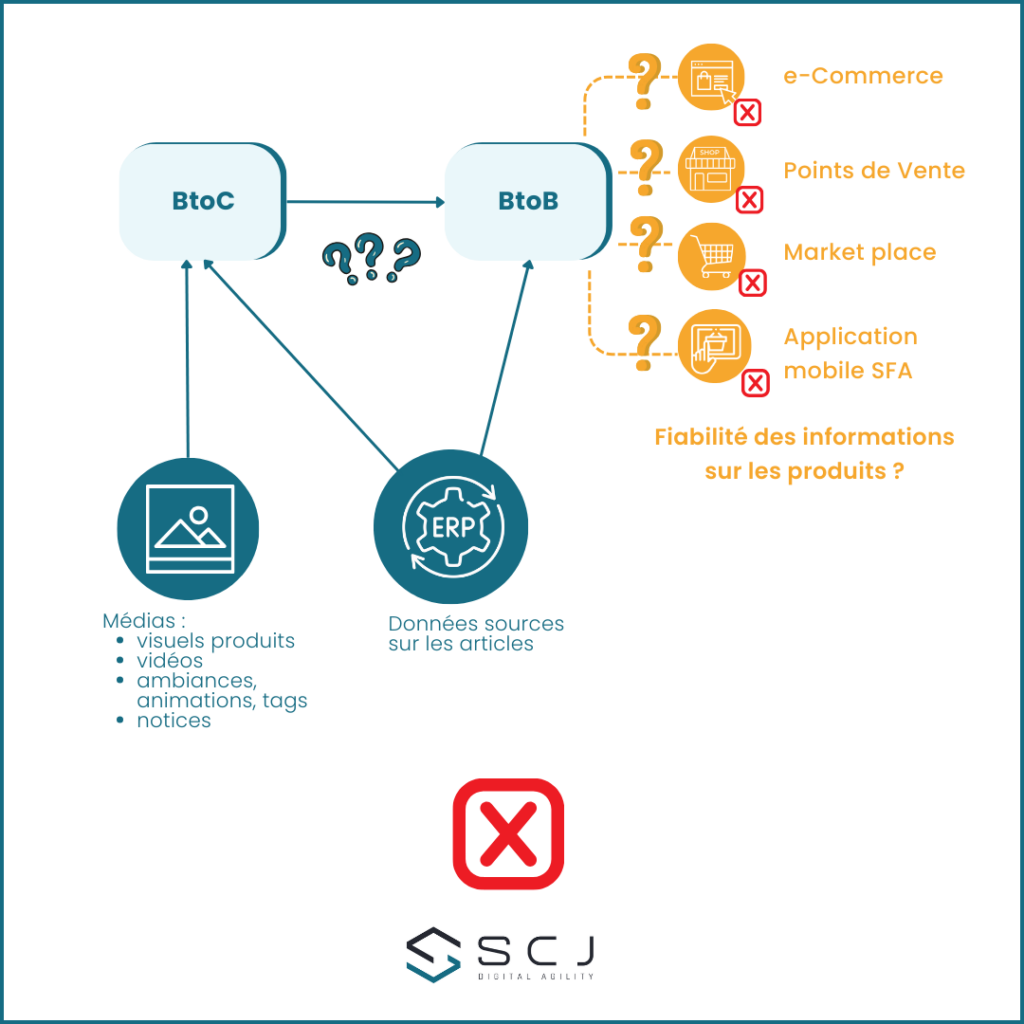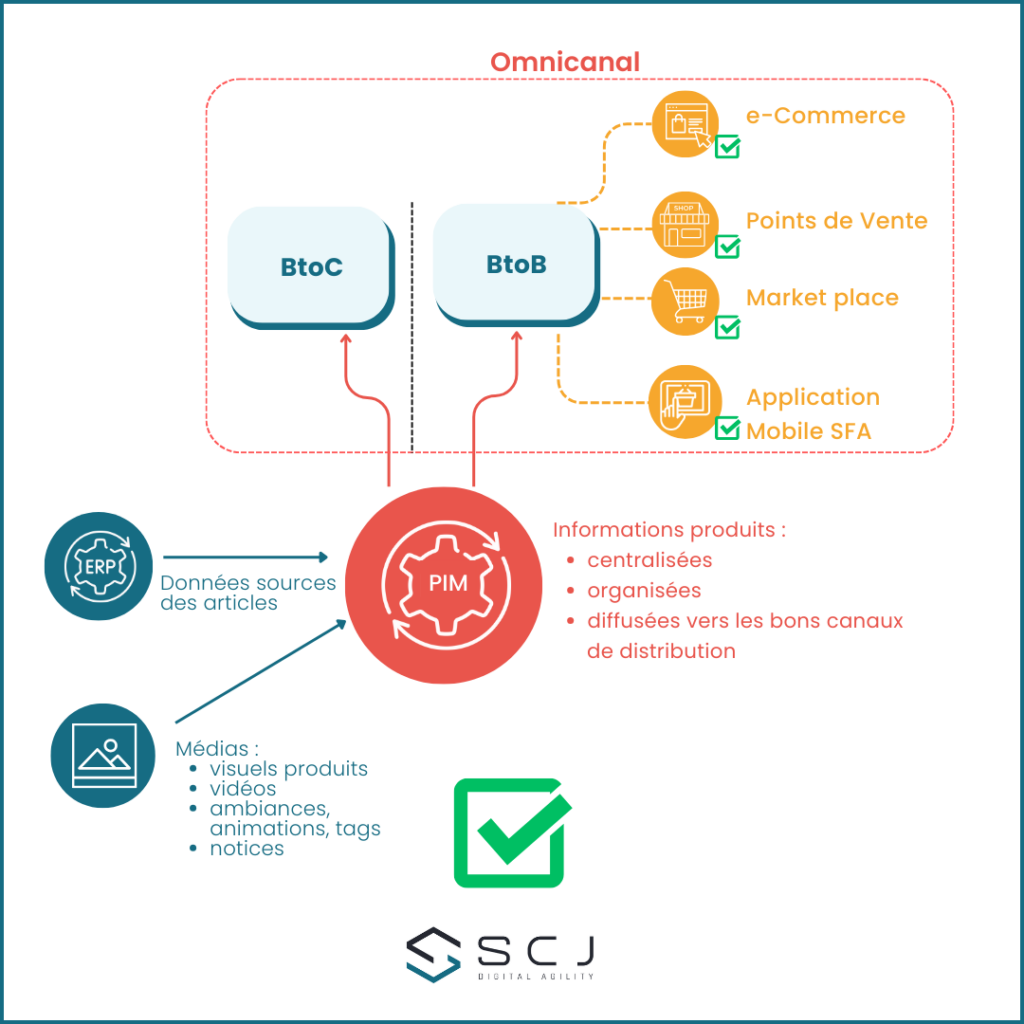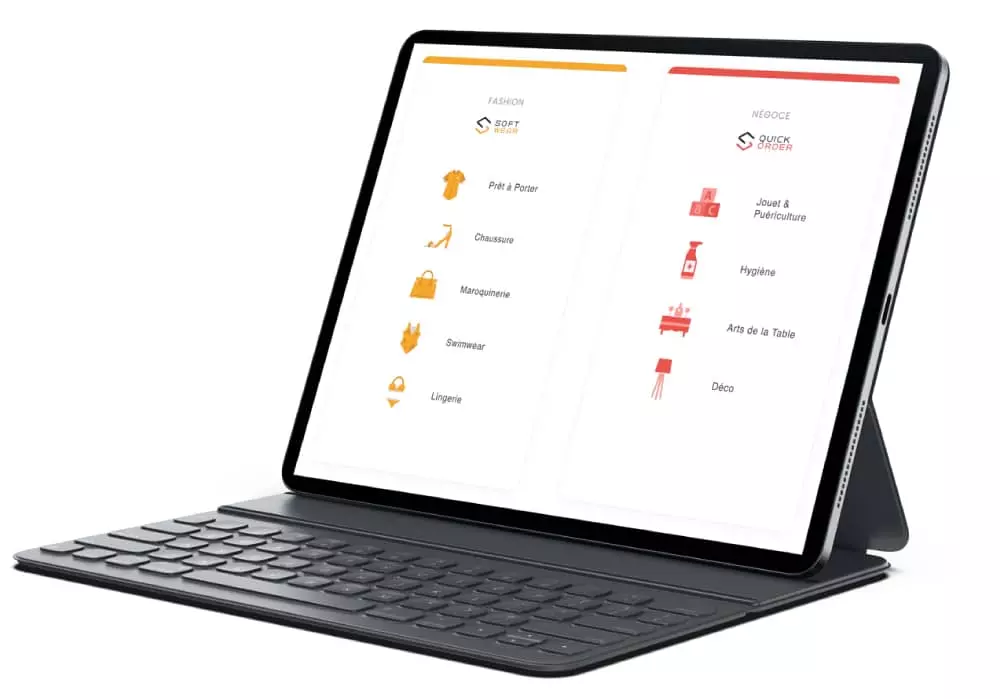B2B e-commerce continues to grow, representing nearly €360 billion in revenue in France (Xerfi, B2B e-Commerce Market in 2026).
Now it’s your turn to get started. However, launching a B2B e-commerce platform isn’t just about putting a product catalog online. Success relies on careful preparation, particularly regarding data structuring, internal organization and choosing the right digital tools.
In this article, we will explore the essential prerequisites for implementing a high-performing B2B e-commerce solution.
1. Organize your commercial data efficiently
Launching a B2B e-commerce site without carefully planning your commercial data organization within your IT system is a mistake to avoid at all costs.
To ensure reliable data, it’s essential to structure your commercial information in advance (products, stock, pricing, etc.). Well-structured data guarantees consistency across all sales channels and seamless management.
Which digital tools should you use? The importance of a solid architecture
In B2B e-commerce, structuring your technical infrastructure correctly from the start is key to optimal management of data and business processes. Choosing the right digital tools — such as an ERP for managing business processes and a PIM for organizing product data — together with a well-designed architecture, allows you to manage data flows more efficiently and gain in performance and agility.
- ERP : the foundation of your e-commerce structure
An ERP (Enterprise Resource Planning) is the central tool that consolidates all essential company information, including orders, inventory, products, clients… It ensures centralization and regular updating of data, enabling smooth coordination across teams. A well-structured ERP prevents order errors, duplicates, and optimizes operational efficiency.
- PIM : your ally for product data management and omnichannel distribution
While an ERP manages overall business processes, a PIM (Product Information Management) centralizes and enriches product-specific information. It guarantees consistency and keeps product information up-to-date across all sales channels (e-commerce, catalogs, marketplaces, etc.).
The PIM handles not only basic data like pricing and descriptions but also technical specifications (dimensions, materials, colors), marketing content (copywriting, tags), and media assets (images, photos, videos). This ensures accurate, updated information across all channels, improving the speed and quality of customer interactions.
For example, in the fashion industry, where differentiating collections, pre-orders (new collection rollouts), and restocks is critical, a PIM allows clear structuring of product information, preventing B2B products from accidentally appearing on B2C channels or new collection items from showing in the restock section.
- CRM : for a centralized management of customer data
A CRM (Customer Relationship Management) system consolidates customer data (purchase history, preferences, interactions) and enables personalized commercial offers. When integrated into your technical infrastructure, it improves customer relationships with a 360° view of interactions and better follow-up.
How to organize your data ?
- Standardized references
The quality of data in your ERP and PIM systems is essential. Ensure each product has a unique, standardized reference to avoid order errors and maintain data consistency.
- Product categories and families
Structuring categories and families allows smooth navigation on your e-commerce site and simplifies product searches for clients.
- Separation of B2B and B2C flows
For companies operating both B2B and B2C, separating the two flows in the PIM is crucial. This prevents B2B-specific products from appearing on B2C channels and ensures relevant information for each segment (technical descriptions, pricing, volumes, commercial terms).
Separation allows relevant information to be provided to each segment without the risk of confusion.


2. Organize your teams: who does what?
The success of your B2B e-commerce project also depends on the clear organization of your various teams. It is essential to define the roles and responsibilities of each person with regard to data organization, to ensure smoother operations.
- Marketing manages events and enriches product pages in the digital catalog : descriptions, products categories, visuals…
- Sales team ensures offers are correctly segmented and adapted to B2B clients : pricing, discounts, commercial terms, delivery conditions…
- IT (or CIO) handles ERP, PIM and e-commerce platform integration to ensure smooth operation and data management.
- A PIM moderator can also be appointed to oversee team organization and verify that product data is managed correctly and regularly updated before publication. For example, they can establish a standard reference system to unify data in a specific format that everyone must adhere to.
3. The importance of good UX/UI design
Although often overlooked in B2B, user experience (UX) and user interface (UI) are key to attracting and retaining professional clients. B2B buyers expect a simple, smooth and intuitive interface, fast response times, and a seamless journey comparable to B2C.
Key points for optimal B2B UX/UI :
- Simplicity et clarity : a B2B e-commerce site must present clear information with simple hierarchies, well-organized menus, search options and accessible filters for intuitive navigation.
- A modern and attractive design : a contemporary look inspires confidence while remaining professional.
- Smooth purchasing path : fewer clicks to complete an order improve customer satisfaction.
- Responsive web design : your B2B e-Commerce site must adapt to all devices (desktop, tablet, smartphone…).
- Optimized loading speed : fast-loading pages prevent frustration and reduce drop-offs.
- Mobile First approach : consider designing a dedicated mobile app for an ergonomics-optimized experience for smartphone users.
4. B2B-specific features
B2B e-commerce requires features tailored to complex client needs.
Key features for a high-performing B2B site :
- Personalized digital catalog : display products according to client profiles (retailers, chains, boutiques, export) with filters for easy navigation.

👉 Pour en savoir plus, découvrez notre article : Comment créer un catalogue digital BtoB avec des fiches produits optimisées ?
- Pricing and terms management : provide flexible pricing management with customized discounts systems based on order volumes or amounts.
- Simplified ordering : one-click order validation, automatic cart saving and order history (for recurring purchases for example).
- Tailored billing and payment options : offer billing solutions tailored to B2B needs, such as deferred payment, credit lines, …
- Sales campaigns and special offers : implement targeted promotions based on buyer profiles, seasonality or special events.
- Multi-store management : allow clients to manage orders across multiple stores from one account.
- Up-to-date stock management : synchronize your data to give your customers visibility into the availability of your products.
- User profile management : control user rights for fully assisted, semi-guided or autonomous purchasing.
Launching a B2B e-commerce platform cannot be improvised. It requires a clear strategy and the right digital tools. With structured internal organization, polished UX/UI design and B2B-specific features, you maximize your chances of a successful e-commerce launch.







